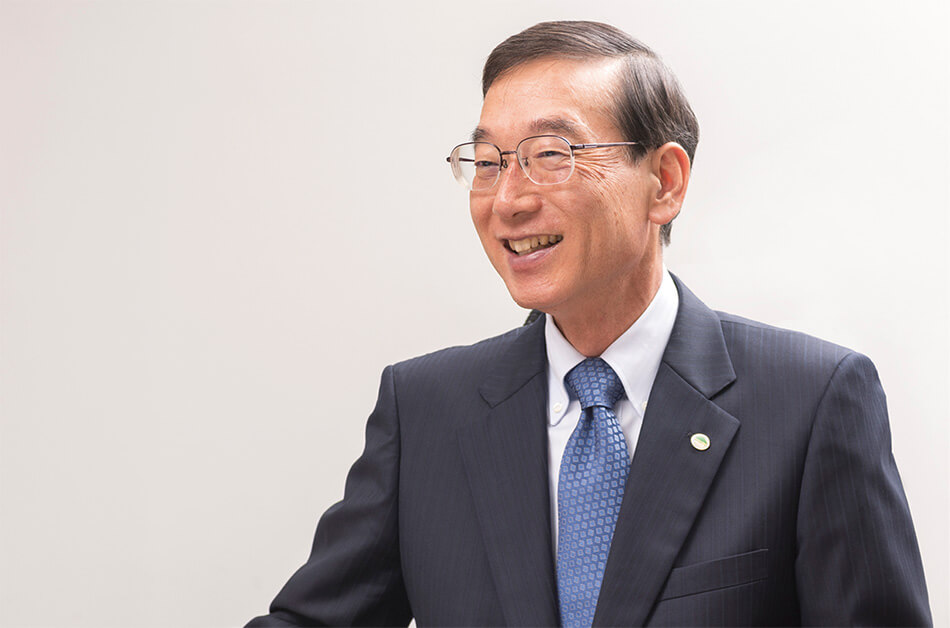Guiding Automotive Society towards the Next Stage
This summer, the governments of first France and then the UK caused a stir by announcing their intention to ban sales of new gasoline and diesel vehicles from 2040. Policies aiming towards eliminating the internal combustion engine can also be seen in countries such as India and the nations of Europe. Meanwhile, in China, the world's largest vehicle market, adoption of electric vehicles (EVs) and plug-in hybrid vehicles (PHVs) is growing rapidly due to more stringent government environmental regulations. In the USA, the Bolt EV from General Motors (GM) is selling well, while Tesla, an EV manufacturer, has a growing presence in the market. It seems clear that the development of EVs will continue to accelerate as charging infrastructure is built around the world.
Alongside electrification, autonomous driving is also gaining attention, with an increased pace of competition in technology development. Information technology (IT) companies that have had little connection to the automotive business are now entering the automotive industry. Within the legal system, it is necessary to resolve issues such as where ultimate responsibility lies for situation assessment, decision-making, and actuation in autonomous driving. Thus, it seems likely that the technology will be introduced step by step, with an eye to progress on establishing a legal framework in Japan and elsewhere. Further advances in technology will be needed to achieve the autonomous driving goals of providing a higher level of safety than a human driver while making travel more comfortable.
Over the last 100 years or so, automobiles have followed an unbroken path of new research and technological development, becoming progressively more advanced through ongoing innovation. They have become an essential part of society, underpinning people's way of life and economic activity throughout the world. It is also true that vehicles have continued to face challenges of air pollution, traffic accidents, and congestion. The current activity in the field of electrification, and the rapid progress of technology for autonomous driving, can be viewed as a necessary revolution. This revolution will enable automotive society to confront these problems and move towards the next stage of greater safety and comfort, while reducing environmental load.
Accumulating Technologies that Influence Core Value and Performance of Vehicles
Behind this revolution are the technologies that will help overcome these social challenges. While dealing with cost issues, the wider adoption of EVs and PHVs is underpinned by improvements in the performance of electric motors, inverters, and lithium-ion batteries. The technology for autonomous driving has been made possible by the progress made in fields such as high-speed data processing and control of vehicle dynamics, as well as cameras, radar, and other sensing devices, as vehicles make greater use of electronics.
Hitachi Automotive Systems has an extensive product range covering the core components for electrification as well as sensors, controllers, actuators, and other devices that support autonomous driving. These technologies represent the fruits of the experience and knowledge of the automotive equipment business, dating back more than 80 years, that Hitachi Automotive Systems has accumulated with our customers in conjunction with our parent, Hitachi, Ltd., and form the basis of our technical capabilities.
Hitachi's automotive equipment business has its origin in Hitachi, Ltd. embarking on the domestic production of electrical components in the 1930s. The scope of our product range has progressively expanded since then, leading to Hitachi, Ltd. acquiring TOKICO Ltd. and Hitachi Unisia Automotive, Ltd. in 2004, and Clarion Co., Ltd. becoming a Hitachi affiliate in 2006. In addition to combining their respective fields of expertise to offer a range of key components for the three elements of environment, safety, and information that are essential for enhancing vehicle value, this also established the framework for supplying integrated system solutions that combine all these elements.
In 2009, Hitachi spun off its automotive equipment division to form Hitachi Automotive Systems, Ltd. By drawing on its past experience, the company is developing a variety of technologies that influence the core value and performance of automobiles, and is supplying them in the form of solutions. These include vehicle control and other technologies for boosting efficiency and reducing the fuel consumption of internal combustion engines, still the primary source of motive power, and for improving driving, turning, and braking, the core factors in dynamic performance.
Resolving Society’s Challenges through Automobiles and Mobility
 Hideaki Seki
Hideaki Seki
President & CEO, Hitachi Automotive Systems, Ltd.
Joined Hitachi, Ltd. in 1979. Following appointments as General Manager of the Business Planning Division for the Urban Development Systems Group in 2004, Deputy General Manager of the Motor Power Systems Division in 2006, Vice President and Board Director of Hitachi Automotive Systems, Ltd., Division Manager of the Powertrain & Electronic Control Systems Division & Head of Sawa Works in 2013, and Executive Vice President in 2014, he was appointed to his current position in April 2015.
The trend towards electrification and autonomous driving is closely related to the emergence of “connected cars,” meaning vehicles equipped with Internet communications to enable real-time information service and more advanced forms of autonomous driving through the collection and analysis of data. As a manifestation of the Internet of Things (IoT), the connected car plays an important role in the Japanese government's Society 5.0 plan for achieving a “Super Smart Society.” Hitachi's Lumada IoT platform and its artificial intelligence (AI), security, and other technologies will likely play an important role in this by helping to make vehicles more connected.
Hitachi is operating its Social Innovation Business with the aim of helping customers and society overcome challenges by combining operational technology (OT) for social infrastructure systems, IT, and a wide range of products. With this broad automotive know-how and technology for digitalization and electrification, Hitachi is extensively deploying precision automotive products and highly efficient control technologies. Taking advantage of these strengths, our aim is to help resolve the challenges faced by society in the fields of automobiles and mobility, by deepening collaboration with other Group companies, and drawing on the comprehensive capabilities of Hitachi.
One example is the development of fleet management solutions that integrate our onboard devices with IT solutions from Hitachi, Ltd. and utilize analytics to support efficiency improvements in logistics. By utilizing such comprehensive technologies, we intend to continue providing solutions for overcoming challenges within the automotive industry.
Aiming to Contribute to the Future of Automotive Society
New technological developments and new entrants to the industry are intensifying development competition in the automotive industry worldwide. Recognizing that research and development are the source of our competitiveness, we are seeking to build on our capabilities by establishing a collaborative framework from a global perspective. To utilize innovative technologies to drive the growth of the automotive sector, we are pursuing open innovation through the global deployment of Hitachi's research and development resources, and by working more closely with our technical centers in North America, Europe, China, and Japan. In addition, we are collaborating with universities and research institutions around the world, including Hitachi's own research and development centers.
Working with partners and strengthening collaborative relationships is also an indispensable part of our product strategy. Hitachi Automotive Electric Motor Systems, Ltd., established jointly with Honda Motor Co., Ltd. in July 2017, is seeking to maintain its competitive advantage in the market for electric vehicles, which is expected to grow in the future, by utilizing synergies in the development of technology for the electric motors at the heart of electric vehicle systems.
As we focus on the trends toward electrification, autonomous driving, and connectivity, we can see the possibility of automobiles taking on an entirely new form. This might even include flying cars like those that appeared in the cartoons we watched as children. To become a company that, even in the future, is able to drive growth and contribute to the role of vehicles in society, we intend to pay close attention to market developments around the world and to the needs of vehicle manufacturers and society, so that we can develop and supply innovative products and solutions on a global scale.

